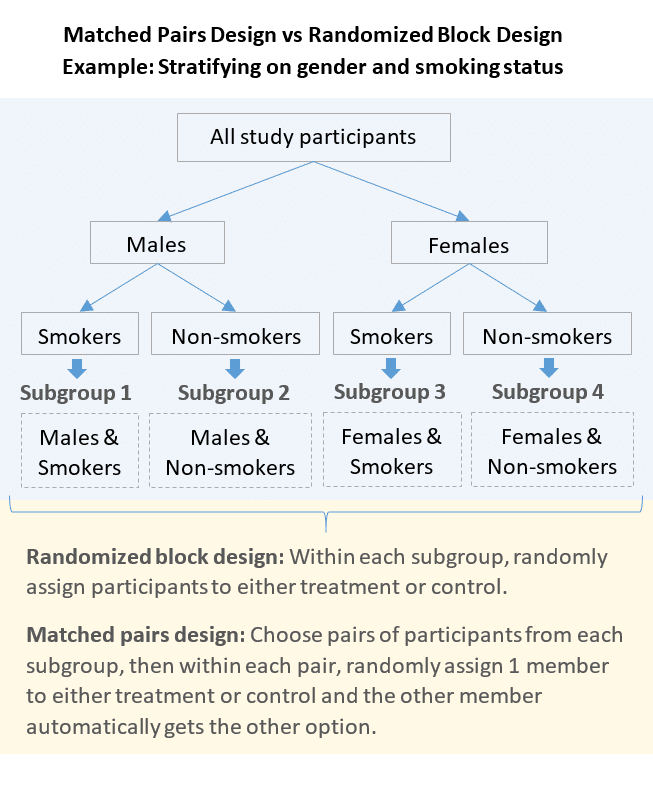In a matched pairs design, treatment options are randomly assigned to pairs of similar participants, whereas in a randomized block design, treatment options are randomly assigned to groups of similar participants. The objective of both is to balance baseline confounding variables by distributing them evenly between the treatment and the control group.
Matched pairs design works in 2 steps:
- Divide participants into pairs by matching each participant with their closest pair regarding some confounding variable(s) like age or gender.
- Within each pair, randomly assign 1 participant to either the treatment or the control group (and the other will be automatically assigned to the other group).
Randomized block design works in 2 steps:
- Divide participants into several subgroups by putting together those who are similar regarding some confounding variable(s) like age or gender.
- Within each subgroup, randomly assign participants to either the treatment or the control group.
Here’s a figure that summarizes the difference between a matched pairs design and a randomized block design that are both trying to equalize the treatment and control groups with regards to gender and smoking status:

When working with a small sample, using simple randomization alone can produce, just by chance, unbalanced groups regarding the patients’ initial characteristics (for a detailed discussion see: Purpose and Limitations of Random Assignment). In these cases, ensuring equivalence between participants by using either a matched pairs design or a randomized block design will increase the statistical power and precision of the study.
Where randomized block design is better:
Matched pairs design may not be the best option in the following cases:
- If an eligible participant will have to wait a long time to be randomized because a suitable match is hard to find.
- If paired participants may not be similar regarding other important characteristics.
- If the subgroups have an odd number of participants. In this case, each will be left with 1 unpaired participant. Losing some participants this way can be problematic in cases where we are already working with a small sample, and/or very few participants are eligible for the study.
Where matched pairs design is better:
Matching is especially useful in cases where participants can be paired with themselves.
For instance, in order to study the effect of a new sunscreen, the new product can be applied to the right arm (the treatment group), and the left arm can be used as control.
Where a completely randomized design is better than both:
Neither matching nor blocking is necessary in studies with large sample sizes, since in these cases, simple randomization alone is enough to balance study groups.
References
- Friedman LM, Furberg CD, DeMets DL, Reboussin DM, Granger CB. Fundamentals of Clinical Trials. 5th edition. Springer; 2015.
- Hulley SB, Cummings SR, Browner WS, Grady DG, Newman TB. Designing Clinical Research. 4th edition. LWW; 2013.